
current / archive / issues / faq / RSS feed / twitter /
What If Doctor Doom Had Become A Hero?
| < previous | next > |
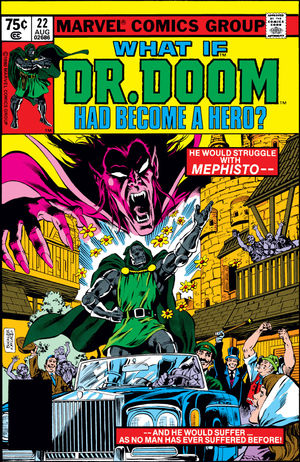 Over the course of Minor Appearances Month 'What If?' has become a sort of second home for Doctor Doom, just like 'Not Brand Ecch' when we looked at the late sixties. This particularly story is, however, not minor at all, comprising a remix of most of Doom's greatest hits so far. For someone who's spent a lot of time reading those hits (and misses!) it's pretty exciting stuff!
Over the course of Minor Appearances Month 'What If?' has become a sort of second home for Doctor Doom, just like 'Not Brand Ecch' when we looked at the late sixties. This particularly story is, however, not minor at all, comprising a remix of most of Doom's greatest hits so far. For someone who's spent a lot of time reading those hits (and misses!) it's pretty exciting stuff!
Unusually for this series, the cover answers it's own question. "What if Dr. Doom had become a hero?" it asks, then comes straight back with "He would struggle with Mephisto... and he would suffer as no man has ever suffered before!" I'm very tempted to say "Thanks, the cover, I don't need to read the rest of this one then", but there is much, much more inside.
It all begins with The Watcher giving a brief recap of Doom's story in the main Marvel Universe, starting with a scene from Doom's very first appearance, way back in Fantastic Four #5. The FF's costumes are drawn correctly for the period, although the Thing is a lot rockier than he was then, but Doctor Doom is drawn in the current version of his costume, not the slightly more medieval one he debuted in.
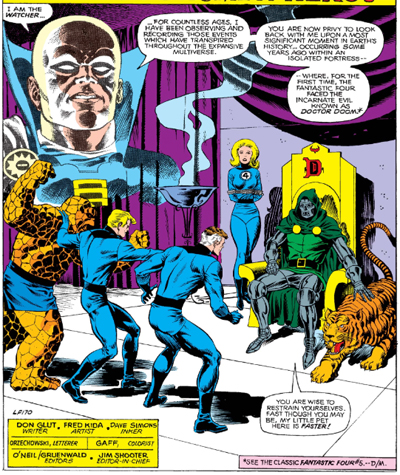 He's also shown with his tunic hitched up to reveal his metal pants. This seemed incongruous at first, until I turned the page and discovered that Fred Kida has drawn The Watcher in exactly the same way!
He's also shown with his tunic hitched up to reveal his metal pants. This seemed incongruous at first, until I turned the page and discovered that Fred Kida has drawn The Watcher in exactly the same way!
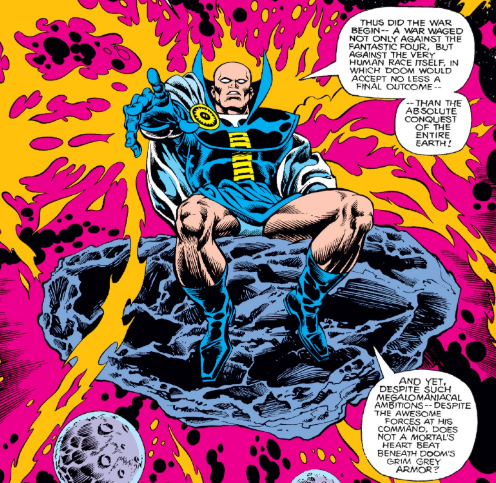 Once we've all recovered from that, The Watcher gives an abbreviated version of Doom's origin as it was told in Fantastic Four Annual #2, with the addition of Valeria's presence, as first seen in Marvel Superheroes #20, and then gives a brief explanation of how Multiverses work using an image very similar to the front cover of DC's "Crisis On Infinite Earths" #1.
Once we've all recovered from that, The Watcher gives an abbreviated version of Doom's origin as it was told in Fantastic Four Annual #2, with the addition of Valeria's presence, as first seen in Marvel Superheroes #20, and then gives a brief explanation of how Multiverses work using an image very similar to the front cover of DC's "Crisis On Infinite Earths" #1.
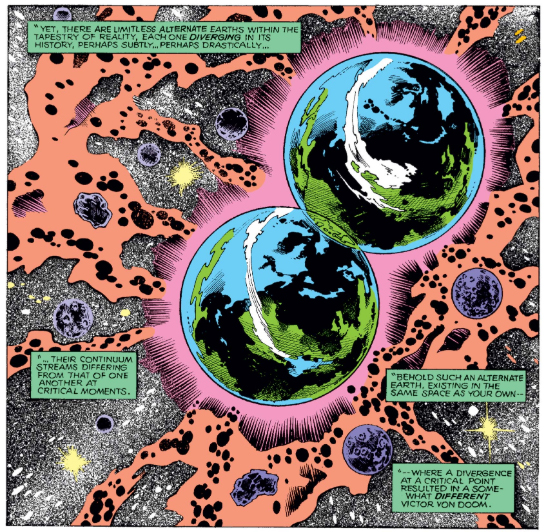
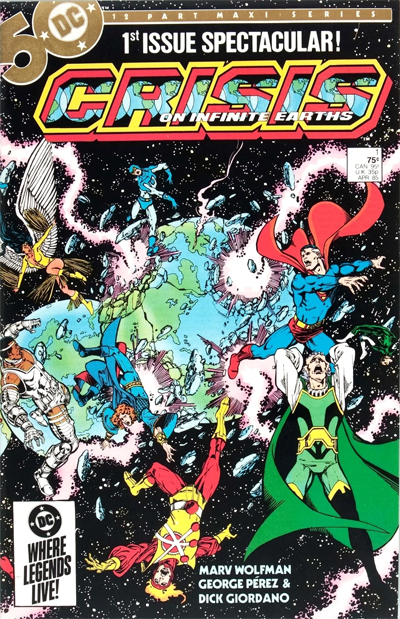 The idea of 'What If?' is that it shows what might have happened if one crucial moment had gone differently, and in this case it's Doom's decision in college to ignore Reed Richards' warning about an error in his calculations, which led to his machine exploding an scarring his face. Here, Victor Von Doom takes moment to calm down, and then asks for an explanation, which leads to Reed fixing the machine. Instead of exploding it works as planned, with Victor visiting the Netherworld where he discovers that his mother is trapped in hell.
The idea of 'What If?' is that it shows what might have happened if one crucial moment had gone differently, and in this case it's Doom's decision in college to ignore Reed Richards' warning about an error in his calculations, which led to his machine exploding an scarring his face. Here, Victor Von Doom takes moment to calm down, and then asks for an explanation, which leads to Reed fixing the machine. Instead of exploding it works as planned, with Victor visiting the Netherworld where he discovers that his mother is trapped in hell.
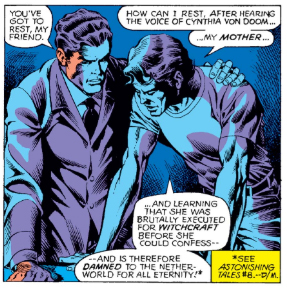 As the note in the panel says, his mother's fate was previously established in Astonishing Tales #8. Clearly Don Glut did his homework before sitting down to write this story, picking out the highlights of Doom's story so far, although the bit about her being damned to hell because she was unable to confess before she died is, I think, a new addition.
As the note in the panel says, his mother's fate was previously established in Astonishing Tales #8. Clearly Don Glut did his homework before sitting down to write this story, picking out the highlights of Doom's story so far, although the bit about her being damned to hell because she was unable to confess before she died is, I think, a new addition.
Another addition is Doom's claim that he is the rightful heir to the Latverian throne. I don't recall this ever being mentioned before, but it'll crop up again later in this story.
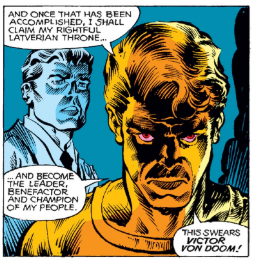 As in the main Marvel Universe, Doom sets out on a quest for knowledge, eventually reaching the same sect of monks who accept him as their master and forge him a suit of armour, although this time it's made of gold with "a helmet befitting a knight of old" rather than grey with a sombre mask.
As in the main Marvel Universe, Doom sets out on a quest for knowledge, eventually reaching the same sect of monks who accept him as their master and forge him a suit of armour, although this time it's made of gold with "a helmet befitting a knight of old" rather than grey with a sombre mask.
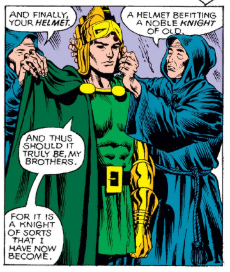 Doom flies off to a nearby cave where he performs a magical ritual which sets his mother free from hell. It only takes a couple of panels to do, and appears to be ridiculously easy. However, when Mephisto, one of hell's "brooding masters" finds out about it, he swears to have his revenge on Doom.
Doom flies off to a nearby cave where he performs a magical ritual which sets his mother free from hell. It only takes a couple of panels to do, and appears to be ridiculously easy. However, when Mephisto, one of hell's "brooding masters" finds out about it, he swears to have his revenge on Doom.
Blissfully ignorant of all this, Doom flies home to "the tiny, storybook kingdom of Latveria" where he discovers that the Baron who caused the death of his father has himself died, leaving the country under the villainous yoke of none other than Prince Rudolfo, first seen in Astonishing Tales #1. He is, to use the correct terminolgy, even more of a dick here than he was then.
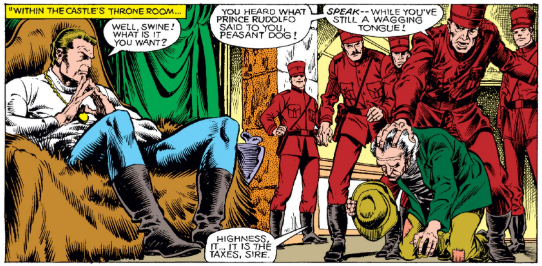 Rudolfo is enraged by a peasant who has come to ask for mercy paying his taxes, which Rudolfo says makes him "no better than this kingdom's thieving gypsy population", setting him at ideological odds with Doom, who promptly bursts in to free the man, fighting off a platoon of royal guards through the medium of laser blasts and... turning them into frogs?
Rudolfo is enraged by a peasant who has come to ask for mercy paying his taxes, which Rudolfo says makes him "no better than this kingdom's thieving gypsy population", setting him at ideological odds with Doom, who promptly bursts in to free the man, fighting off a platoon of royal guards through the medium of laser blasts and... turning them into frogs?
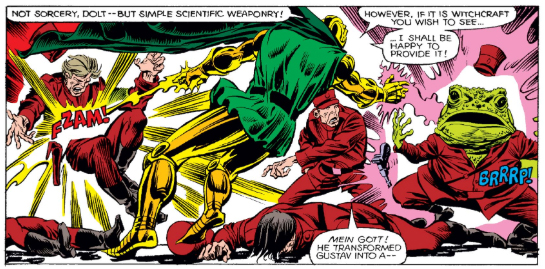 It's great to see that even in this universe, Doom still calls his enemies "Dolt"!
It's great to see that even in this universe, Doom still calls his enemies "Dolt"!
Rudolfo is mortally wounded in the battle, but with his dying breath he crows that he will die without Doom knowing "the richest secret" about himself.
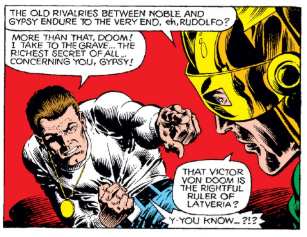 Rudolofo dies, from his wound or from the shock, leaving Doom able to rush down to the dungeons and free all the gipsy prisoners that have been kept there, including his ongoing supporting characters, Valeria and Boris.
Rudolofo dies, from his wound or from the shock, leaving Doom able to rush down to the dungeons and free all the gipsy prisoners that have been kept there, including his ongoing supporting characters, Valeria and Boris.
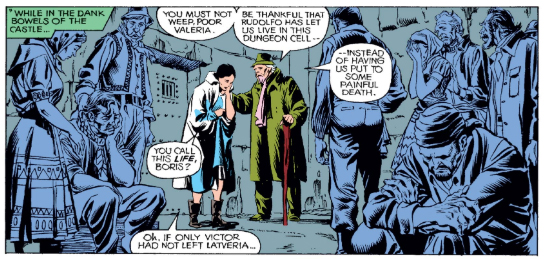 Doom becomes King, not through revolution but from birthright, and brings about great changes to the country, notably through the provision of tractors and arc welding equipment. This delights the peasantry who salute the King and his fiancee as they walk through the streets of Latveria, in another callback to an image first seen in Fantastic Four Annual #2 and homaged many times since.
Doom becomes King, not through revolution but from birthright, and brings about great changes to the country, notably through the provision of tractors and arc welding equipment. This delights the peasantry who salute the King and his fiancee as they walk through the streets of Latveria, in another callback to an image first seen in Fantastic Four Annual #2 and homaged many times since.
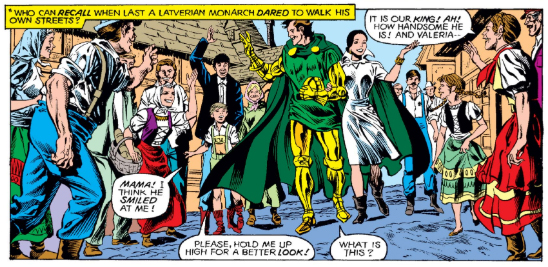
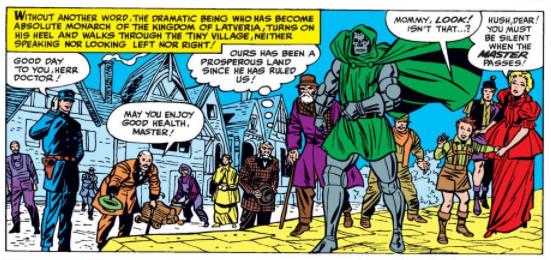 The pair marry and the whole country celebrates, but just as they're heading off on their honeymoon Doom suddenly finds himself standing on "what appears to be some god-forsaken asteroid", where Mephisto tells him that he's stolen Latveria, put it into an orb, and trapped the whole country in hell, as compensation for the loss of Doom's mother's soul.
The pair marry and the whole country celebrates, but just as they're heading off on their honeymoon Doom suddenly finds himself standing on "what appears to be some god-forsaken asteroid", where Mephisto tells him that he's stolen Latveria, put it into an orb, and trapped the whole country in hell, as compensation for the loss of Doom's mother's soul.
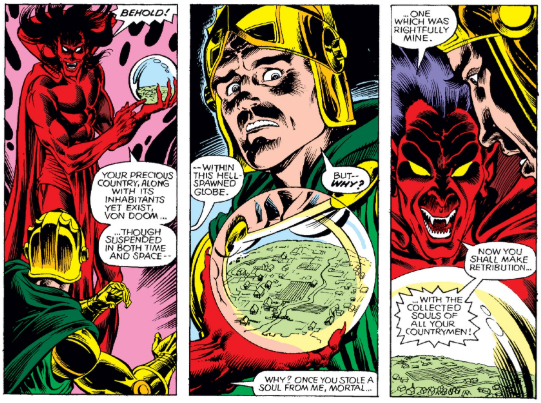 I'm neither a theologian nor a lawyer, but it seems to me as if Mephisto has taken things a bit too far here. Surely a whole country isn't repayment for a single person? Sadly there isn't an ombudsman for Doom to complain to, so instead he launches into a Big Fight with Mephisto, which ends very badly for him.
I'm neither a theologian nor a lawyer, but it seems to me as if Mephisto has taken things a bit too far here. Surely a whole country isn't repayment for a single person? Sadly there isn't an ombudsman for Doom to complain to, so instead he launches into a Big Fight with Mephisto, which ends very badly for him.
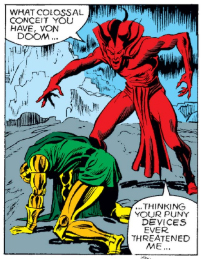 Mephisto, perhaps aware of the unjustness of his original plan, offers Doom a way out. He'll swap all of Latveria for just one soul - that of either Valeria, or Doom himself!
Mephisto, perhaps aware of the unjustness of his original plan, offers Doom a way out. He'll swap all of Latveria for just one soul - that of either Valeria, or Doom himself!
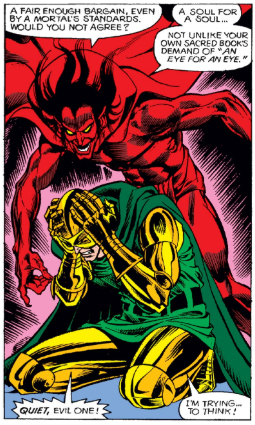 Normally, in a superhero story, the hero would offer himself up willingly to save the eternal soul of his country and his wife, but Doom is not that kind of hero and, after grappling with the issue, decides that "the world must not be deprived of Doom", and Mephisto takes Valeria's soul instead. Immediately Doom is returned to the car, where his wife has suddenly disappeared.
Normally, in a superhero story, the hero would offer himself up willingly to save the eternal soul of his country and his wife, but Doom is not that kind of hero and, after grappling with the issue, decides that "the world must not be deprived of Doom", and Mephisto takes Valeria's soul instead. Immediately Doom is returned to the car, where his wife has suddenly disappeared.
 The story then flashes forward several years to mid-summer's eve where, just as in Astonishing Tales #8, Doom is doing battle with Mephisto's demons for the soul of a woman that he loves - only this time it's his wife, rather than his mother.
The story then flashes forward several years to mid-summer's eve where, just as in Astonishing Tales #8, Doom is doing battle with Mephisto's demons for the soul of a woman that he loves - only this time it's his wife, rather than his mother.
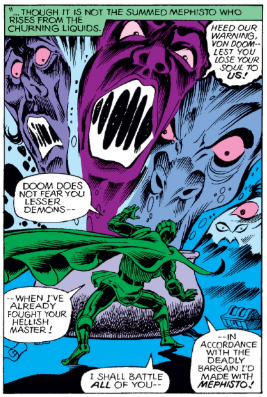
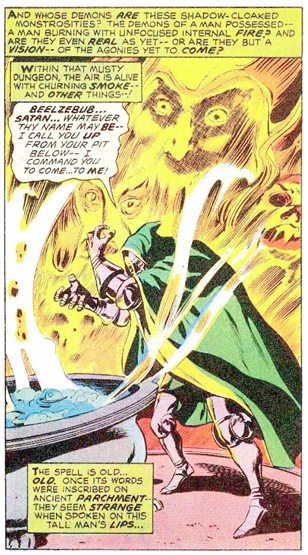 As with the original version of the story, Doom fails, and the issue ends with Boris watching as his master retires, beaten, but promising himself that he'll try again next year.
As with the original version of the story, Doom fails, and the issue ends with Boris watching as his master retires, beaten, but promising himself that he'll try again next year.
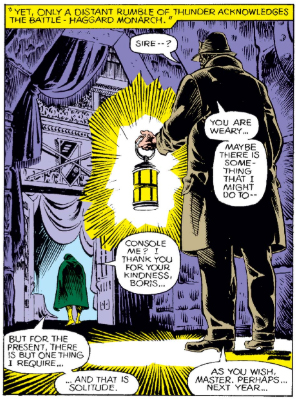 It's a downbeat ending which doesn't have a lot to do with him becoming a hero, but does follow a distinct pattern for "What If?" stories, which always seem to end either with everybody dying or, as here, things turning out pretty much the same as they did in the main universe, if with a slight twist.
It's a downbeat ending which doesn't have a lot to do with him becoming a hero, but does follow a distinct pattern for "What If?" stories, which always seem to end either with everybody dying or, as here, things turning out pretty much the same as they did in the main universe, if with a slight twist.
Despite the slightly standard ending, this has been a fascinating story which, as I said at the start, takes us on a tour of most of Doom's greatest hits so far. Next time, however, we're back to a single panel appearances, as Minor Appearances staggers towards a climax!
link to information about this issue
posted 11/12/2019 by Mark Hibbett
| < previous | next > |
Comments: